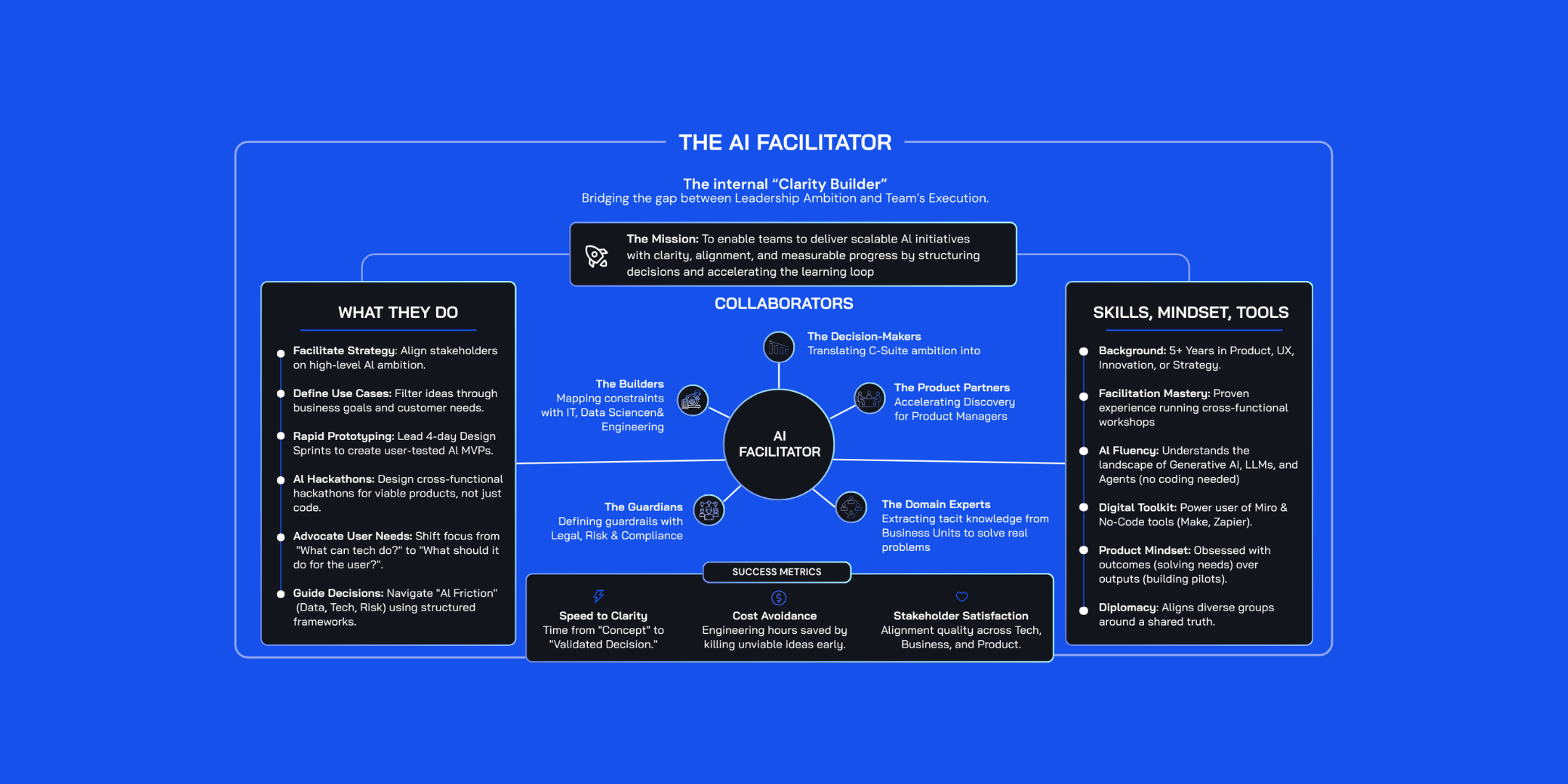How to Align Stakeholders and Find Growth Opportunities? A Newspaper Story.

The Challenge
A prominent, long-established newspaper found its traditional business model increasingly at risk. With the steady decline in print circulation, largely due to an aging and diminishing readership, the need for transformation was clear. The organization recognized the urgency to expand its digital presence and diversify its audience. The goal was to attract a younger, more tech-savvy demographic, pivoting from their traditional print stronghold to a more dynamic, digital-first approach. However, despite the clarity of their overall goal, the leadership team faced a significant challenge: determining where to begin this transformation.
What should we do next? Where do we start?
The Solution
This is where Design Sprint Academy stepped in, providing strategic direction and actionable steps for the digital transition. Leveraging a mix of business intelligence, data, and customer insights, we conducted a comprehensive one and a half-day Problem Framing Workshop with the leadership team to align their vision. Our collaborative approach enabled them to define and prioritize opportunities that presented value not only for the business but also for the new, tech-savvy audience they aimed to captivate.
The Results
In stark contrast to the previous six months, which were marked by indecision and circular discussions, the Problem Framing Workshop proved to be a turning point. It culminated in the identification of five well-defined opportunities - strategic bets crucial for the newspaper's transition to digital. More importantly, for each of these opportunities, the team crafted clear action plans to initiate their journey.
However, perhaps the most significant outcome was the newfound alignment within the leadership team. This alignment not only clarified the path forward but also empowered their respective teams to confidently advance towards implementation.
The HOW - Step by Step Breakdown of the Engagement
Context
The leadership team of the newspaper had long recognized the necessity of transitioning to a digital model. However, the path forward was unclear. As many other organizations embarking on their digital transformation journeys do, an initial attempt was to heavily invest in developing an app. Despite pouring a significant seven-figure budget into this project, the app only managed to attract fewer than a thousand customers — a stark disappointment that not only drained resources but also cast doubt on future digital initiatives. This failed attempt left the team hesitant to allocate large budgets to other projects, resulting in a pseudo-alignment that led to stagnation. For about six months, the team found themselves in a standstill, with no tangible progress or decisive actions taken.
Running out of time and faced with mounting pressure and a team eager for direction, the stakeholders recognized the need for a decisive shift in strategy. This led them to agree on a Problem Framing Workshop facilitated by Design Sprint Academy. This workshop was envisioned as a crucial step to break the deadlock and provide the team with much-needed clarity and direction for moving forward in their digital transformation journey.
Preparing the workshop
When we started working on the project, one thing was clear. We did not have another six months to make a decision — swift, decisive action was needed.
Stakeholder Interviews: We began by conducting brief, focused interviews with the six members of the leadership team. These 20 to 30-minute one-on-one sessions aimed to understand their perspectives on the current situation, their goals, and the outcomes they desired. It quickly became apparent that, despite a unanimous agreement on the need for digital transition, their visions on how to achieve this and what success would look like varied significantly. No wonder they were not able to make a decision for so long, when they had such different perspectives.
Analyzing Customer Insights: Next, we turned our attention to the new, younger audience the newspaper was aiming to engage. Here, we found an abundance of data compiled by their research team, presented across fifteen documents of varying formats, including PDFs, PowerPoint presentations, and Excel sheets. The depth and breadth of this research were extensive, offering a wealth of data, charts, and tables. However, the sheer volume of information was overwhelming, rendering it difficult to translate into clear, actionable insights.
These initial findings shaped our approach for the upcoming workshop. Our goal was twofold: first, to foster alignment among the diverse stakeholders, and second, to facilitate their understanding of the customer data, thereby enabling them to make well-informed decisions.
Aligning Stakeholders: To achieve alignment, we decided to employ an Industry Context Map. We prepared a large, blank template of this map, intending to use it interactively during the workshop. This tool was chosen for its effectiveness in clarifying industry dynamics and helping stakeholders understand their position within the broader market context.
Visualizing Customer Data: To make the extensive customer data more accessible and actionable, we translated it into a visual customer journey map. Printed in a large format (4 meters by 1.5 meters), this visualization was designed to be a focal point in the workshop. It aimed to drive discussions and provide the leadership team with a clear, customer-centric perspective, highlighting what their target audience needs and wants.
Equipped with these artefacts, we set the stage for a productive 1.5-day workshop with the leadership team, confident that our structured approach would drive meaningful insights and decisive actions.
The Problem Framing Workshop
The workshop began with a deep dive into the problem space, utilizing the Industry Context Map we had prepared. This exercise was guided by a key principle:
To change the game, you need to know what game you’re in.
The Industry Context Map set the stage for productive discussions, serving several crucial functions:
- Expanding Perspectives: It pushed the team to think beyond the immediate confines of their products and organizational boundaries, encouraging broader and more strategic thinking.
- Global Contextualization: This tool facilitated in-depth discussions about global trends and future challenges, offering insights into their potential impact on the newspaper's business.
- Bridging Perception Gaps: The map also helped decrease perception gaps among team members, fostering a shared understanding and mutual comprehension.
As the morning progressed, the initially blank template transformed into a canvas rich with insights. This visual depiction gradually revealed a comprehensive picture of the current state of their newspaper business, revealing both challenges and promising opportunities. Crucially, it aligned the team's perspectives, setting a solid foundation for the decisions ahead.

In the afternoon, it was time for the team to shift focus from an internal business perspective to a more customer-centric viewpoint, aiming to better understand how the audience interacts with their products and services. This shift was facilitated using the customer journey map we had prepared based on the research data prior to the workshop.
Engaging with this map was really eye-opening for the stakeholder team:
- Initiating the Conversation: The map served as a starting point, helping the team understand the readers' context and the ways they engage with digital content.
- Introducing New Perspectives: By visually outlining the customer journey, the map brought different perspectives to the fore, encouraging the team to reassess their initial viewpoints.
- Diagnosing and Identifying: More than just a visual tool, the map was key in diagnosing pain points within the customer experience, thereby uncovering new opportunities for improvement and innovation.
This exercise completed the team's understanding of the problem by introducing the readers’ perspective, setting the stage for more customer-aligned decision-making.

As the first day of the workshop drew to a close it was time to bring it all together. The team had achieved alignment on both their business needs and goals, as well as their customers' desired outcomes and the barriers preventing these. Inspired by all of these insights the team brainstormed opportunities that promised value for both the business and its customers.
We concluded the day prioritizing five significant opportunities for their digital transition. The grounding of these opportunities in factual data and insights instilled confidence in the team about moving forward with them. There was still work ahead, but that was for the next morning, approached with renewed energy and a clear mind.

On the second day, spanning from morning to noon, the team revisited the opportunities they had identified. Their goal was to add substance to these initial ideas, transforming them into comprehensive opportunity statements. This process involved specifying the particular customer problems being addressed, the contexts in which these problems occur, and the expected value to the business, including KPIs and success metrics. Equally important was articulating the value these opportunities would bring to customers.
Such detailed and clear articulation ensured that there was no room for misinterpretation. These well-defined problem statements served as the foundation for the rest of the team to develop a concrete action plan and kick-start the actual implementation phase.
In just a day and a half, the leadership team made more progress than they had managed in the previous six months. This rapid progress was a testament to the power of focused, collaborative problem-solving and strategic alignment.



.jpg)





